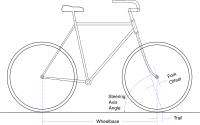Bicycle and motorcycle geometry

Bicycle and motorcycle geometry refers to the way the different parts of the bike are arranged and how they affect how the bike feels and handles. Imagine you are playing with LEGOs and you want to make a car. You can choose to put the wheels really close together or far apart, make the car long or short, or make the steering wheel go way over to one side or not very much. All of these choices will make the car feel and handle differently when you drive it around.
Now, when people design bikes, they make a lot of choices like this to get the bike to work the way they want. They can choose how far apart to put the wheels, how long to make the frame, where to put the pedals and handlebars, and much more. These choices all affect how the bike feels when you ride it.
For example, imagine you are riding a bike with really wide handlebars. You can easily steer the bike but it might feel a little wobbly when you go fast. This is because the wide handlebars give you a lot of leverage to turn the bike, but they are also harder to control when you are going really fast. On the other hand, if you are riding a bike with really narrow handlebars, it might feel more stable at high speeds but harder to steer.
Similarly, the angle of the frame, or the "headtube angle" as it is called, affects how the bike handles. A steeper headtube angle will make the bike feel more responsive and nimble, but also a little twitchy and unstable at high speeds. A shallower headtube angle will make the bike feel more stable and secure at high speeds, but less maneuverable.
These are just a few examples of how bike geometry affects how it rides. The same principles apply to motorcycles, but since they are generally faster and heavier than bicycles, some of the choices are different. But the basic idea is the same: the way the different parts of the bike are arranged determines how it feels and handles.
Now, when people design bikes, they make a lot of choices like this to get the bike to work the way they want. They can choose how far apart to put the wheels, how long to make the frame, where to put the pedals and handlebars, and much more. These choices all affect how the bike feels when you ride it.
For example, imagine you are riding a bike with really wide handlebars. You can easily steer the bike but it might feel a little wobbly when you go fast. This is because the wide handlebars give you a lot of leverage to turn the bike, but they are also harder to control when you are going really fast. On the other hand, if you are riding a bike with really narrow handlebars, it might feel more stable at high speeds but harder to steer.
Similarly, the angle of the frame, or the "headtube angle" as it is called, affects how the bike handles. A steeper headtube angle will make the bike feel more responsive and nimble, but also a little twitchy and unstable at high speeds. A shallower headtube angle will make the bike feel more stable and secure at high speeds, but less maneuverable.
These are just a few examples of how bike geometry affects how it rides. The same principles apply to motorcycles, but since they are generally faster and heavier than bicycles, some of the choices are different. But the basic idea is the same: the way the different parts of the bike are arranged determines how it feels and handles.
Related topics others have asked about:
